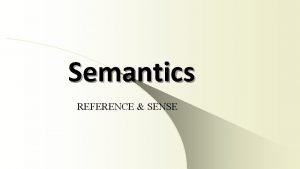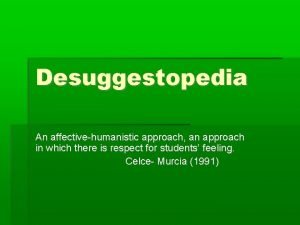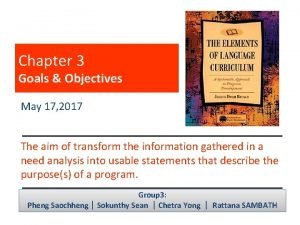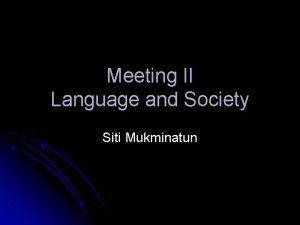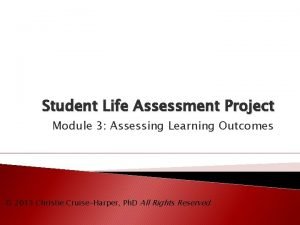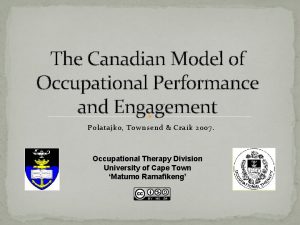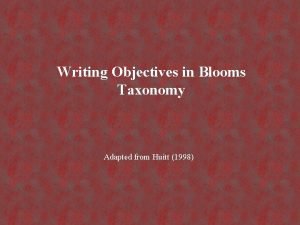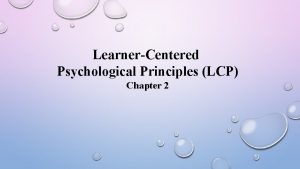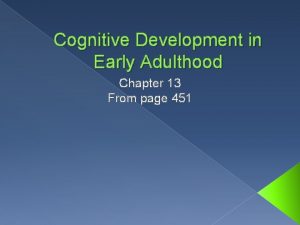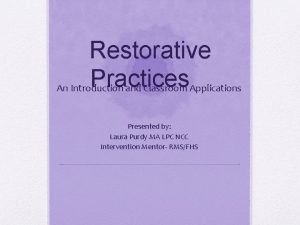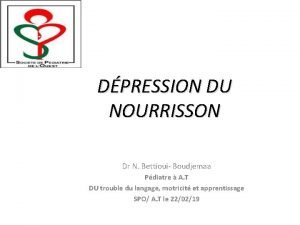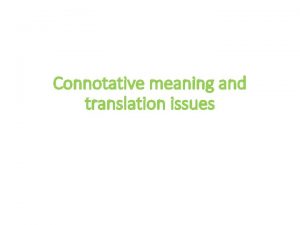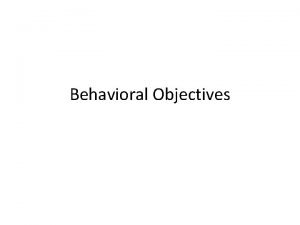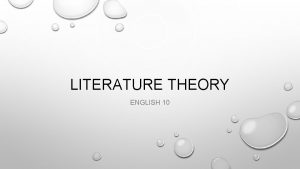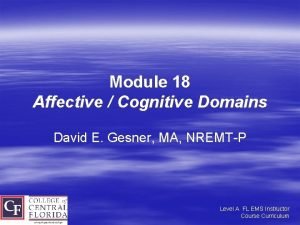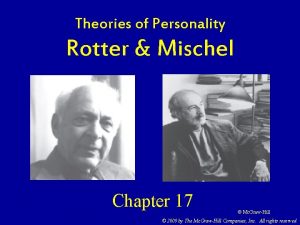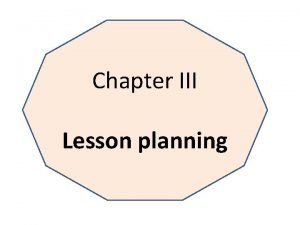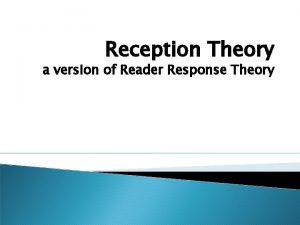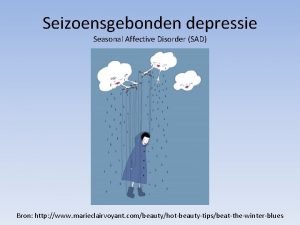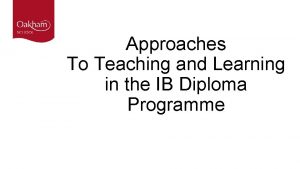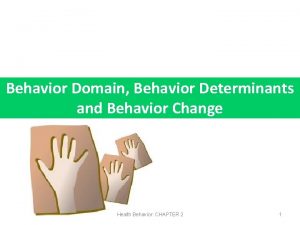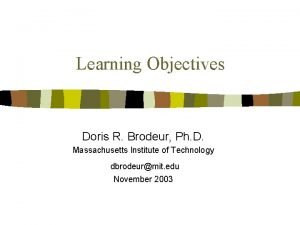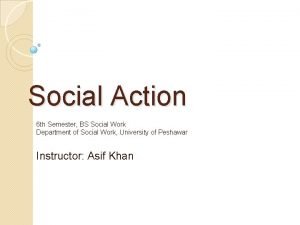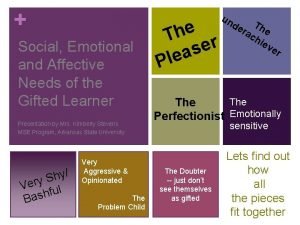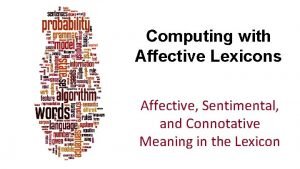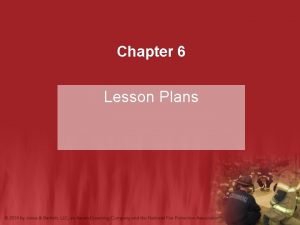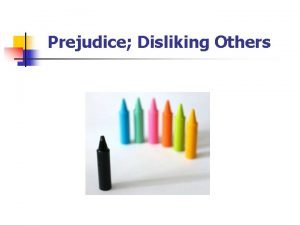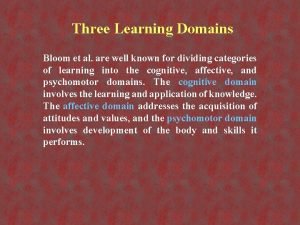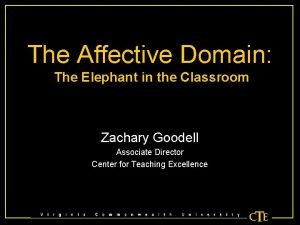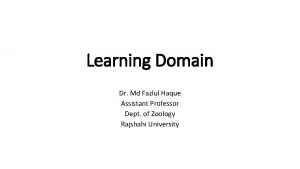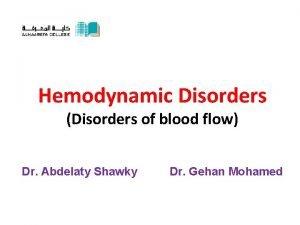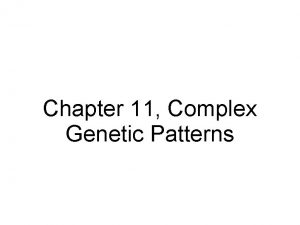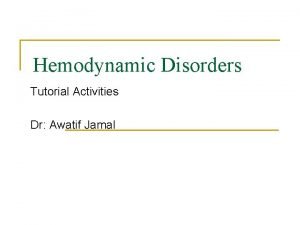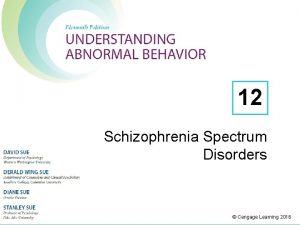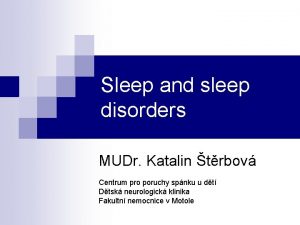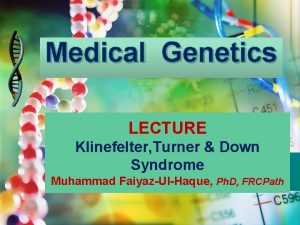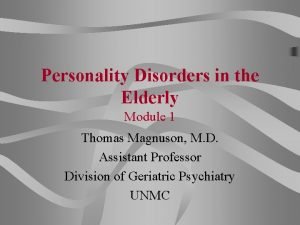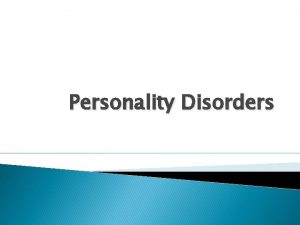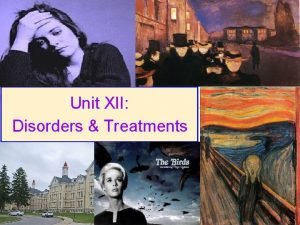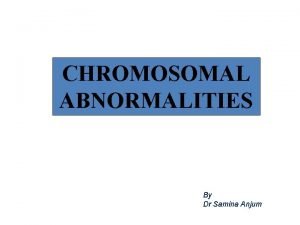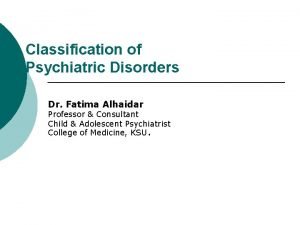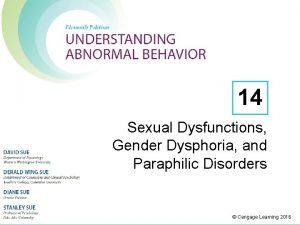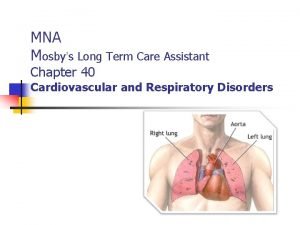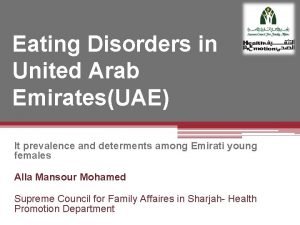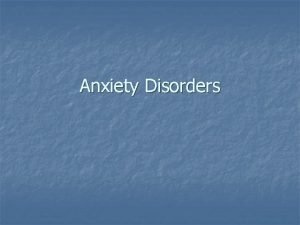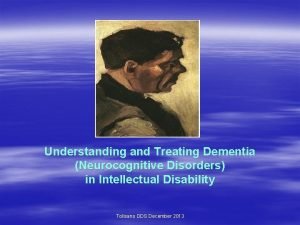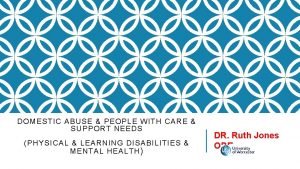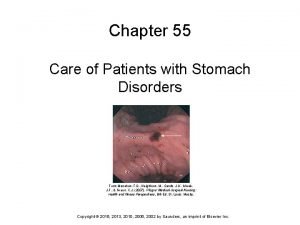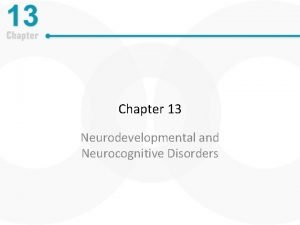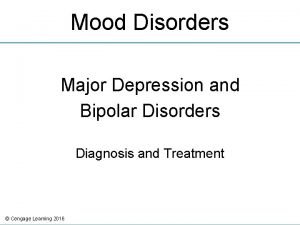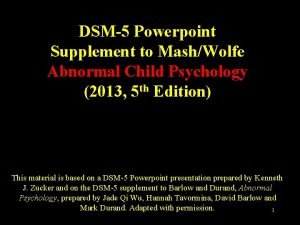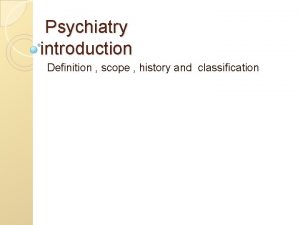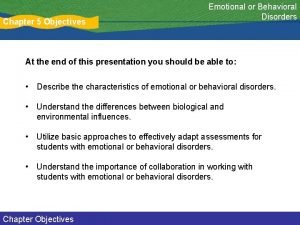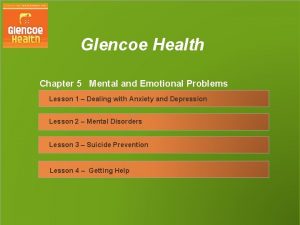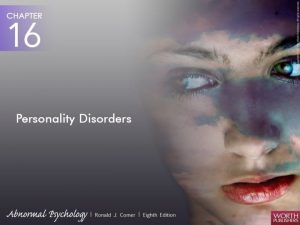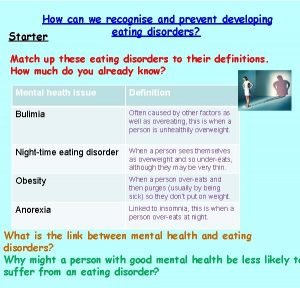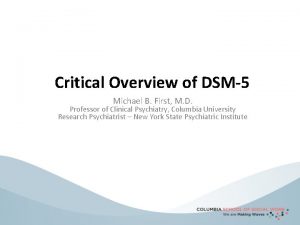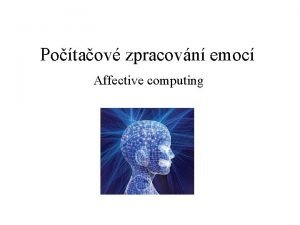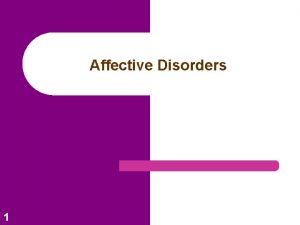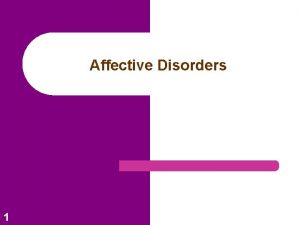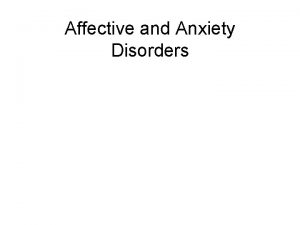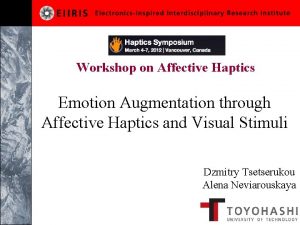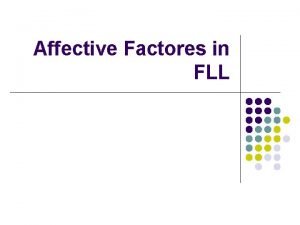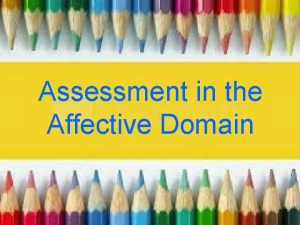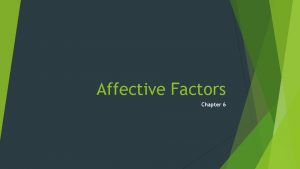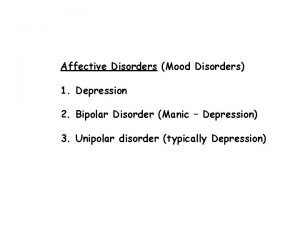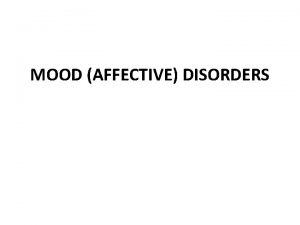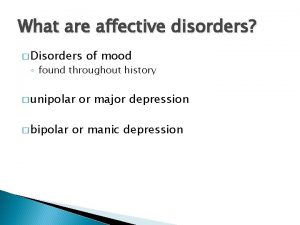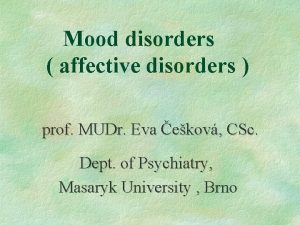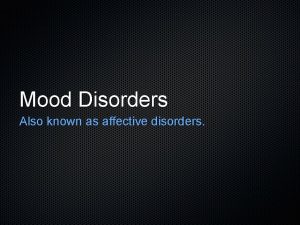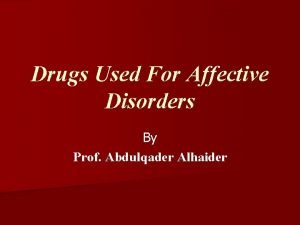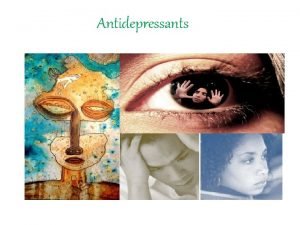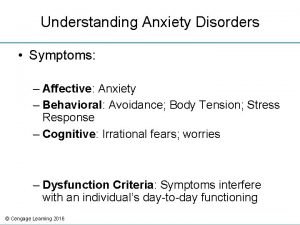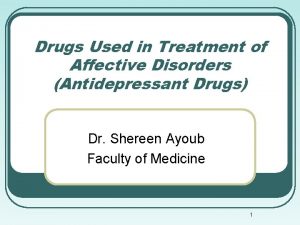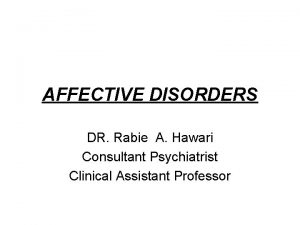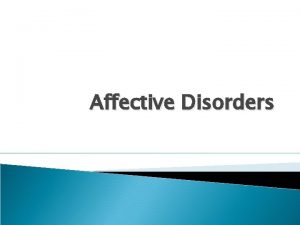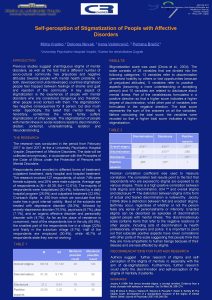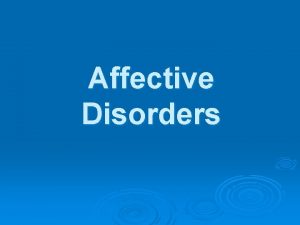Affective Disorders 1 Affective Disorders 2 U S















































































- Slides: 79

Affective Disorders 1

Affective Disorders 2 U. S. Canada Anxiety Disorder BR 12 LTR 18% 30% 12% 20% Mood Disorder BR 12 LTR 9% 17% 6% 12%

Affective Disorders Issues 1. Emotional states: adaptive and non-adaptive negative emotionality 2. Feelings: the experience and expression of emotional states 3. Misattribution: confusing content and cause of emotional states 3

Affective Disorders Issues Ø Normal and clinical depression Ø Primary and secondary affective disorders (e. g. “dual diagnosis”) Ø Comorbidity (especially with Anxiety disorders) 4

Affective Disorders Differential Diagnosis Ø Mood disorder due to General Medical Condition Ø Substance-induced Mood Disorder Ø Adjustment Disorder with Depressed Mood Ø “Negative emotion disorder Ø “Pseudodementia” Ø “Manic Depression” 5

Affective Disorders Types: Prevalence Lifetime risk A. Unipolar 4+% 12% 2+% 3. Manic depression 1% 4. Cyclothymia 1% 1% 6+% 12+% 1. Major depression 2. Dysthymia 12+% B. Bipolar Canadian Totals 6 2+%

Affective Disorders Dysthymia Ø Clinical picture Ø Personality: from “neurosis” to “temperament” Ø “Double depression” 7

Affective Disorders Major Depressive Disorder Descriptive features Ø symptoms Ø severity Ø single & recurrent episodes Ø incidence Ø course 8

Affective Disorders Major Depressive Disorder Treatment Ø chemotherapy (“antidepressants”) Ø Spontaneous remission and. . . ØOld research ØNewer research ØNewest research 9

Affective Disorders Major Depressive Disorder Distinctions a. b. c. d. 10 exogenous/endogenous (distal causes? ) major/minor (severity)? psychotic/neurotic (severity → cause)? melancholic/non-melancholic (proximal causes) e. Note: f. depression with “psychotic” features depression with “atypical” features

Affective Disorders Major Depressive Disorder Signs of “melancholia”: Ø Ø 11 family history early onset insidious onset normally not

Affective Disorders Major Depressive Disorder Symptoms of “melancholia”: Ø Ø 12 vegetative appetite and weight loss early morning wakening pleasures of the chase and the feast

Affective Disorders Explanations A. Biogenesis 1. Genetics Ø concordance rates, old and new Ø adoptions, old and new Ø Ø prospective retrospective Ø possibilities Ø Ø Ø 13 direct influence of genes interactive influence of genes

Affective Disorders Explanations A. Biogenesis 2. Biology of negative emotionality Ø The original theory Ø The monoamine hypotheses, old and new 14

Biology of negative emotionality: 15

Affective Disorders Explanations A. Biogenesis 2. Biology of negative emotionality Ø The “first generation” antidepressants Ø Ø tricyclics and their anticholinergic “side effects” MAOIs and “the cheese effect Ø The “second generation” antidepressants Ø Ø 16 SSRIs (eg Prozac, Paxil, Zoloft Atypicals (eg Asendin, Effexor, Wellbutrin Dual action (eg Serzone, Remeron) Others (eg SNRIs, reversible MAOIs, herbs

Affective Disorders Explanations Do antidepressants work? Ø The controversy, revisited Ø The new numbers Ø The drug alternatives Ø Ø Ø Cocaine : dopamine reuptake Ecstasy : serotonin release Amphetamines : monoamine release Ø The suicide risk 17

Affective Disorders Explanations Ø Biological factors, continued § § 18 genes age experience gene/experience interactions

Affective Disorders Explanations 3. Developments 1. 2. 19 Body: cortisol and the DST Brain: lateralization of emotion Ø frontal involvement of glutamate Ø involvement of memory : hippocampus & amygdala Ø neurobiology of sleep

Affective Disorders Explanations B. Psychogenesis 1. Psychodynamic theory Ø Freud’s “anaclitic” depression Ø Bowlby’s Attachment theory Ø Klerman’s Interpersonal therapy (IPT) 20

Affective Disorders Explanations 2. Learning theory Ø Rewards : “Response contingent positive reinforcement Ø rewards activities Ø Behavioural Activation Treatment 21

Affective Disorders Explanations Punishments : “Learned Helplessness” and beyond Ø Cognition : “Pessimistic Attributional Style” (internal, global, stable) Ø Learned Helplessness: “The negative triad” (helplessness and hopelessness) thoughts emotions Ø Psychological immunization (helplessness and hopelessness) Ø Modern Cognitive Therapy Ø “Mindfulness-based Cognitive Therapy” 22

Affective Disorders Explanations Some research: “The Dodo Bird Verdict” . . . and beyond 1. 2. 3. 4. 23 drugs IPT cognitive therapy placebo

Affective Disorders Explanations 2. Phenomenological theory Ø Humanistic perspective : actualization Ø The alternative (and the Existentialists) Ø Logotherapy 24

Affective Disorders Explanations C. Sociocultural aspects Cause: sociogenesis Content: autonomous and sociotropic people Course: interpersonal factors in prognosis 25

Affective Disorders Summary Major Depressive Disorders: melancholic and non-melancholic: personality factors & disorders? Dysthymia primary and secondary: melancholic and non-melancholic? Treatment drugs and the alternatives: specific patient-symptom & non-specific factor approaches 26

Affective Disorders Notes 1. ECT (“Shock Theraoy”) Ø Ø Transcranial Magnetic Stimulation Deep Brain Stimulation 2. SAD (“Depression with a Seasonal Pattern”) Ø Ø Melatonin and the Pineal Gland Light Therapies 3. PDD (“Premenstrual Dysphoric Disorder”) Ø Ø 27 Premenstrual Syndrome The controversy

Affective Disorders Notes 4. Post-Partum Syndromes: Ø Ø Ø “Maternity Blues” “Post-Partum Depression” “Psychotic Depression in the Postpartum Period” 5. The Sex Difference Ø Ø 28 Predisposing factors Reinforcing factors

Affective Disorders Bipolar Disorder and Cyclothymia A. Descriptive factors: 1. Manic and depressed episodes Ø Ø Ø Mixed and rapid cycling Bipolar I and II Suicide 2. Cyclothymia Ø Ø 29 Personality Controversy

Affective Disorders Bipolar Disorder and Cyclothymia A. Biogenesis 1. Genetic Ø Ø Concordance rates, then and now Adoptions, retrospective and prospective Possibilities: direct influence of genes? 2. Biology of mania Ø The hypotheses B. Psychogenesis Ø 30 cause and content

Affective Disorders Bipolar Disorder and Cyclothymia C. Therapy Ø Ø 31 Lithium and its alternatives Anticonvulsants (e. g. Tegretol, Valproate, Lamictal) Atypical Antipsychotics (e. g Risperadol, Zyprexa, Abilify) What else?

Affective Disorders Schizoaffective Disorder Differential Diagnosis Ø Depression with “mood congruent delusions” Ø Schizophrenia with “secondary depression” Ø A perspective, and a treatment (Symbyax) 32

Affective Disorders Suicide Ø Social problems and psychiatric ones Ø Rates, worldwide and Canadian Ø Trends in Canada 33

Affective Disorders Suicide Reasons: 1. Disinhibitors: “social involvement and identity” Ø egoistic Ø altruistic Ø anomic 2. Motivations: “escape from self” / ”psychache” Ø standards and expectations Ø stresses, setbacks and self-blame Ø self-awareness 34

Affective Disorders Suicide Summary: “Why people die by suicide”: “Disconnectedness and Ineffectiveness” Issues: 1. Ambivalence Ø Ø Ø “to be” “not to be” “maybe” 2. Intervention Ø Ø Ø 35 passive suicide assisted suicide euthanasia

Affective Disorders Issues: 3. Prevention Ø Ø Ø societal solutions imitation and contagion (“The Werther Effect”) the biology of suicide 4. Prediction Ø Ø Ø predicting rare events predicting in practice the predictors • • • 36 past attempts (the best predictor) present plan (availability of lethal means) person (social support)

Somatoform & Dissociative Disorders 37

Somatoform disorder What is happening here? 1. Conversion (“hysteria”) – – – 38 Sensory and motor symptoms Over and under-diagnosis Purpose? Compare: “self serving bias” and “self-handicapping” Notes: “La belle indefference” and lateralizatoin Conversion, selective attention and dissociation

Somatoform disorder 2. Somatization Diagnosis – Theory – Therapy – Chronic Conversion? – 39

Somatoform disorder 3. Hypochondriasis (and “cyberchondria”) Medical preoccupations – Other needs (and “medical offset”)? – 40

Somatoform disorder 4. Somatoform pain Painful preoccupations – Primary and secondary gains? – 5. Body Dismorphia Physical preoccupations – Some possibilities (and “muscle dysmorphia”)? – Groups, forms, old and new 41

Somatoform disorder Malingering: Malingering deceit with a purpose Factitious disorder: disorder Munchausen syndrome Note: self-induced and “proxy” forms 42

Dissociative disorder What is happening here? Hypnosis and the study of “dual consciousness” “Pre-attentive Processing” 1. “Dry”: the research in the lab. . . the how of “implicit perception and memory” 2. “Wet”: the experience of everyday life. . . the why of “intentional not-thinking” 43

Dissociative disorder Autobiographies: “deep” and “superficial” memories Autobiographies. . . the facts, feelings and fictions Demonstrations of dissociation: group & personal ones dissociation. . . the Dissociative Experience Scale 44

Dissociative disorder 1. Dissociative Amnesia Ø Motivated lack of awareness Ø Recovered Memories 1. “Dry”: the learning theory view of memory . . . how learning and memory serve external, adaptive needs 2. “Wet”: the psychodynamic view of memory . . . how learning and memory serve internal, personal needs The lesson from life: “the complexity of awareness about highly traumatic events” 45

Dissociative disorder 2. Dissociative Fugue Ø Motivated lack of awareness and movement Ø Episodic, declarative and procedural memory 46

Dissociative disorder 3. Dissociative Identity Disorder Ø Over and under-diagnosis: “Multiple Personality Disorder” and its problems Ø Post-traumatic Theory (and “asymmetrical amnesia”) Ø Sociocognitive view (and “iatrogenic illness”) Ø Notes: suggestibility and dissociation-proneness 47

Dissociative disorder 4. Depersonalization Disorder Ø Derealization: “where am I? ” and “out-of-body” experiences Ø Depersonalization: “who am I? ” and “partial dissociation” Note: The story of “Possession/trance disorder” 48

Eating Disorders and Obesity 49

Eating Disorders and Obesity 1. Anorexia Diagnosable and otherwise 2. Bulimia Purging and non-purging 3. “Binge-eating disorder” DSM – V controversies 50

Eating Disorders and Obesity Base rates, clinical and sub-clinical A. Family context: “expressed emotionality” B. Personal context: “Clusters B and C” C. Cultural context: social expectations 51

Eating Disorders and Obesity Beyond the obvious, clinical and sub-clinical The biological context • causes, effects and correlates • comorbidities with eating disorder 52

Psychological Factors and Physical Illness (Axis IV) History 1. Psychodynamic (“psychological”) viewpoint: Personality Illness 2. Psychophysiological (“biological”) viewpoint: “Weak link” + stress Illness 53

Psychological Factors and Physical Illness (Axis IV) History 3. Modern Behavioral Medicine and “Health Psychology” Cause, course, care and cure Comparisons of physical health { 2000 { 1900 54 45 – 50 dehydration, TB, pneumonia 80+ coronary and cancers

Psychological Factors and Physical Illness (Axis IV) 1. Peptic Ulcers Dispositional and situational factors in doudenal ulcers. . . from monkeys to men to helicobacter pylori and beyond 2. Immunocompetence Stress and the hypothalamus in immunosuppression. . . from cortisol to hormones to neurons, and beyond 55

Psychological Factors and Physical Illness (Axis IV) 3. Cardiovascular disorders Coronary heart disease Type A in causation and prognosis Beyond Type A: anxiety, depression and “Type D” 1. Exercise: the evidence 2. Alcohol: the evidence 56

Psychological Factors and Physical Illness (Axis IV) 57

Psychological Factors and Physical Illness (Axis IV) 3. Cardiovascular disorders Essential hypertension Factors: “repressed rage” and beyond Implications for treatment: constructive expression of anger 58

Psychological Factors 59

Psychological Factors and Physical Illness (Axis IV) The importance of prevention! 60

Personality Disorders (Axis II) 61

Personality Disorders (Axis II) • • • Why axes? Why diagnosis? Diagnostic criteria that don’t work: 1. Theoretical criterion: personality isn’t pathology 2. Personal criterion: ego syntonic vs. ego dystonic disorders 3. Social criterion: eccentricity isn’t pathology 62

Personality Disorders (Axis II) • Base rates (and comorbidity) • Prognosis 63

Personality Disorders (Axis II) Cluster A: “Eccentric” 1. Schizoid (solitary) 2. Schizotypal (idiosyncratic) 3. Paranoid (vigilant) 64

Personality Disorders (Axis II) Cluster B: “Erratic” 1. Borderline (mercurial) 2. Narcissistic (self-confident) 3. Histrionic (dramatic) 4. Antisocial (adventurous) 65

Personality Disorders (Axis II) Cluster C: “Anxious” 1. Avoidant (sensitive) 2. Obsessive-compulsive (conscientious) 3. Dependent (devoted) 66

Personality Disorders (Axis II) Cluster D: In the appendix. . . 1. Passive-aggressive 2. “Depressive” 67

Personality Disorders (Axis II) Note, also. . 1. “Sadistic” 2. “Self-defeating” 68

Antisocial Personality Disorder 69

History Moral insanity, psychopathy and “The Mask of Sanity” The DSM: from “Sociopathic Personality Disorder” to “Antisocial Personality Disorder” - the problem in principle: no symptoms - the problem in practice: no reliability 70

History The Modern Criteria and prevalence rates The new problem: criteria “too broad and too narrow” The Psychopathy Checklist “Successful Psychopaths” 71

Research A. Biology, then and now Concordances: monozygous and dizygous Adoption: retrospective and prospective Cross-fostering observations Other longitudinal research: “Deviant children grown up” : predictors (Robins) Prognosis in adulthood 72

Research B. Psychological factors, then and now Parents and their children: Attachment Theory and the “affectionless psychopath” (Bowlby) Adaptation to Life and “sociopathy” (Vaillant) “Failed encounters” and the “fledgling psychopath” (Moffit et al) Cross-cultural studies Gene-environment interactions: MAO-A and maltreatment 73

Theory 1. The (“primary”) Psychopath 2. The Sociopath (or “secondary psychopath”) e. g Two types of children (Frick) The difference it makes 74

Theory The nature of psychopathy The context (e. g “mixed incentive task”) Passive avoidance conditioning The “low fear” model (Lykken) 75

Theory: “an inhibitory deficiency” BAS (Behavioral Activation System) BIS (Behavioral Inhibition System) Theory, updated: Emotional and cognitive components 76

Theory The “two-edged sword” of antisocial behavior: comorbidities and their implications 77

Theory C. Sociocultural factors, then and now “The Psychopathic Society” “The Psychopath within” Beyond psychopathy: the nature of evil the concept of insanity 78

Impulse Control Disorder 1. Intermittent explosion 2. Kleptomania 3. Pyromania 4. Pathological gambling 5. Trichotillomania 79
 Social meaning in semantics
Social meaning in semantics Example of semantic differential scale
Example of semantic differential scale Affective-humanistic approach
Affective-humanistic approach Psychomotor verbs
Psychomotor verbs Formality scale in sociolinguistics
Formality scale in sociolinguistics Affective domain assessment tools
Affective domain assessment tools Cmop-e
Cmop-e Halimbawa ng affective domain
Halimbawa ng affective domain 6 principles of cognitive and metacognitive factors
6 principles of cognitive and metacognitive factors Labouvie-vief pragmatic thought
Labouvie-vief pragmatic thought Higher order skills examples
Higher order skills examples Examples of affective statements
Examples of affective statements Pdiatre
Pdiatre Affective meaning examples
Affective meaning examples Affective behavior at the level of valuing
Affective behavior at the level of valuing Affective theory in literature
Affective theory in literature Affective nurturance-love examples
Affective nurturance-love examples Affective objectives examples
Affective objectives examples Rotter defined maladaptive behavior as behavior that
Rotter defined maladaptive behavior as behavior that Psychomotor examples in lesson plan
Psychomotor examples in lesson plan Affective curriculum
Affective curriculum Affective stylistics reader response theory
Affective stylistics reader response theory Symptomen van seasonal affective disorder
Symptomen van seasonal affective disorder Approaches to teaching and learning ib
Approaches to teaching and learning ib Domains of behavior
Domains of behavior Examples of affective domain learning objectives
Examples of affective domain learning objectives Social action by max weber
Social action by max weber Level of affective domain
Level of affective domain Affective needs of gifted students
Affective needs of gifted students Affective meaning examples
Affective meaning examples Affective domain verbs
Affective domain verbs Affective prejudice
Affective prejudice Action verbs for affective domain
Action verbs for affective domain Personally directed play
Personally directed play Cognitive message strategies
Cognitive message strategies Affective domain
Affective domain Examples of affective domain learning objectives
Examples of affective domain learning objectives Cardiovascular system diseases and disorders chapter 8
Cardiovascular system diseases and disorders chapter 8 Hemodynamic disorders
Hemodynamic disorders Chapter 12 schizophrenia spectrum disorders
Chapter 12 schizophrenia spectrum disorders Is baldness dominant or recessive
Is baldness dominant or recessive Gross
Gross Chapter 12 schizophrenia spectrum disorders
Chapter 12 schizophrenia spectrum disorders Flinders model of care
Flinders model of care Nursing diagnosis for pud
Nursing diagnosis for pud Chapter 15 nervous system diseases and disorders
Chapter 15 nervous system diseases and disorders Sleep disorders
Sleep disorders Monosomy x
Monosomy x Cluster b
Cluster b Who analgesic ladder
Who analgesic ladder Seborrheic keratoses
Seborrheic keratoses York eating disorders service
York eating disorders service Personality disorder
Personality disorder Types of somatic disorder
Types of somatic disorder Bipolar disorder meaning
Bipolar disorder meaning Chromosome 13 abnormality
Chromosome 13 abnormality Tromboemboly
Tromboemboly Medical model psychology
Medical model psychology Neurosis vs psychosis
Neurosis vs psychosis Paraphilic
Paraphilic Wheezing
Wheezing Eating disorders in uae
Eating disorders in uae Anxiety disorders def
Anxiety disorders def Concept mapping chapter 11 genetic disorders
Concept mapping chapter 11 genetic disorders Neurocognitive disorders
Neurocognitive disorders The uk national disorders
The uk national disorders Chapter 55 care of patients with stomach disorders
Chapter 55 care of patients with stomach disorders Mild neurocognitive disorder
Mild neurocognitive disorder When performing a hand skin and nail analysis
When performing a hand skin and nail analysis Mood disorders dsm 5
Mood disorders dsm 5 Axis 1 and axis 2 disorders
Axis 1 and axis 2 disorders Dominant gene disorders
Dominant gene disorders Chapter 17 reproductive system diseases and disorders
Chapter 17 reproductive system diseases and disorders Childhood disorders dsm-5 ppt
Childhood disorders dsm-5 ppt Thought broadcasting
Thought broadcasting Behavioral disorders
Behavioral disorders Glencoe health chapter 5 vocabulary
Glencoe health chapter 5 vocabulary Avoidant personality traits
Avoidant personality traits How to spot eating disorders
How to spot eating disorders Dsm v sexual disorders
Dsm v sexual disorders
